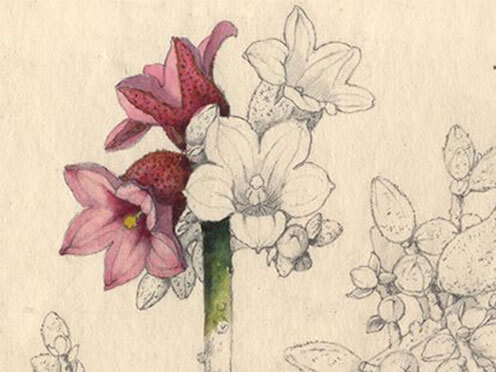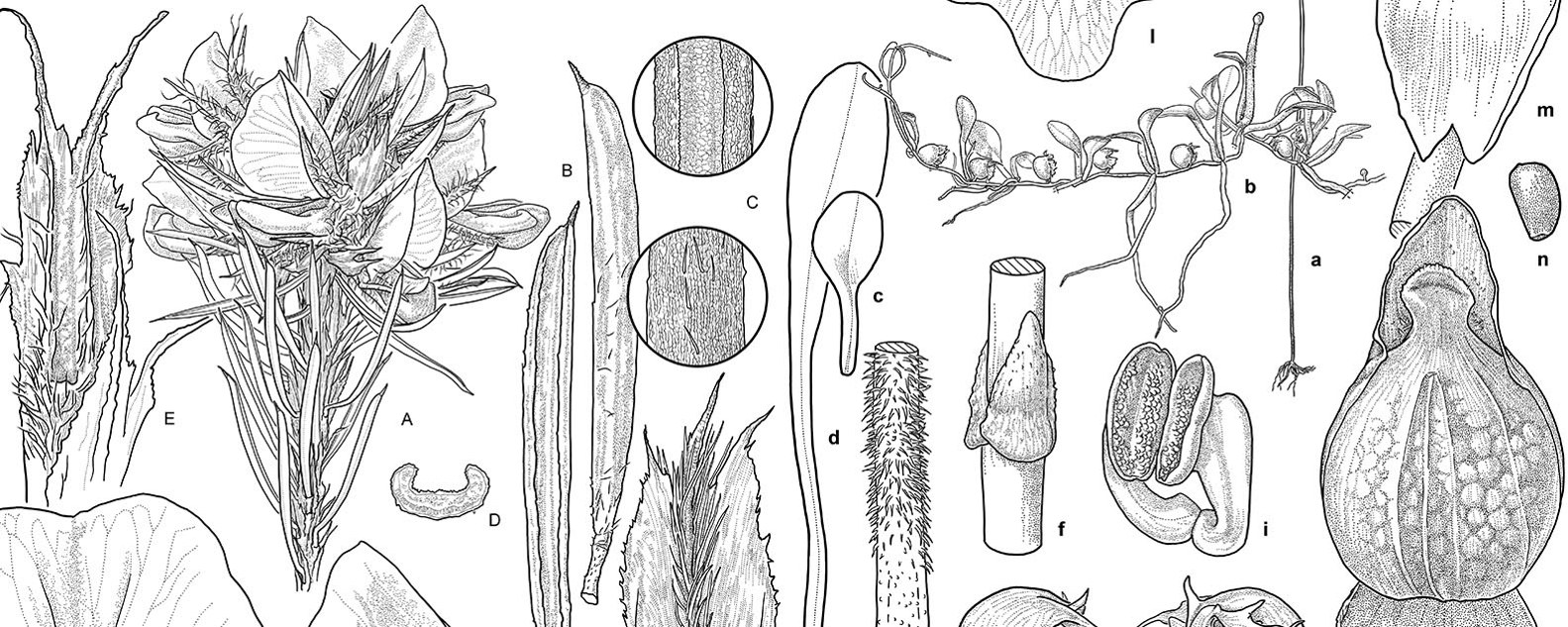Margaret Flockton Award 2025
Exhibition open 8 – 29 August 2025
The Garden Gallery, Royal Botanic Garden Sydney
10am – 4pm, free entry
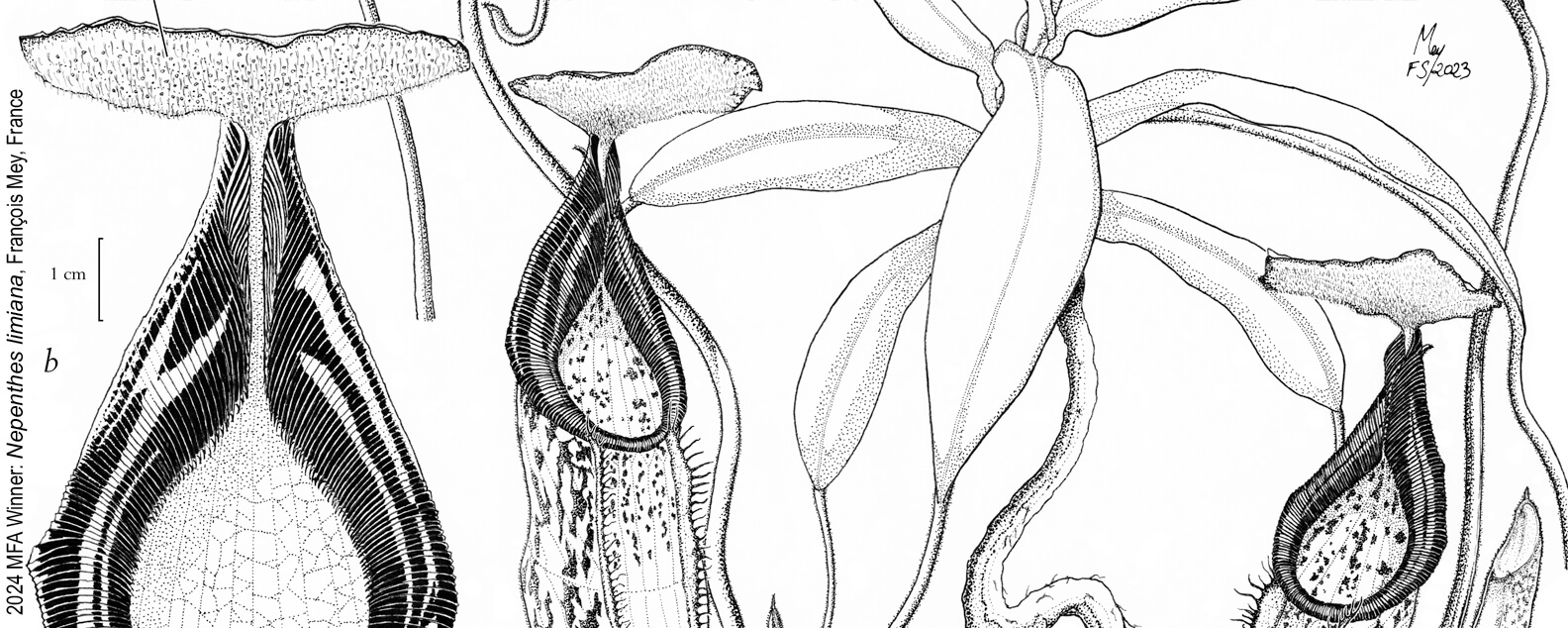
The Margaret Flockton Award is an annual, international award for excellence in scientific botanical illustration.
It also commemorates the contributions that Margaret Flockton (1861–1953), the Royal Botanic Garden Sydney's first scientific illustrator, made to Australian scientific botanical illustration.
Every year, illustrators from around the world submit scientifically accurate drawings that accompany the published taxonomic description of a plant, clearly highlighting all of the distinctive features of the species. Original taxonomic illustrations are highly detailed black and white drawings primarily undertaken in pen and ink, pencil or digitally rendered.
The Maple-Brown Family and Foundation & Friends of the Botanic Gardens sponsor the Margaret Flockton Award.
Image credit: François Sockhom Mey
What is scientific botanical illustration?
2025 selected exhibiting artists
| Atay, Canan (TUR) | Macedo, Thamiris (BRA) |
| Behrens, Irene (ARG) | Mariș, Ivona (ROM) |
| Bhuchaisri, Wanwisa (THA) | McDonald, Peta (AUS) |
| Breedlove, Sophya (USA) | Migoya, María Alejandra (ARG) |
| Chen, Annie (TWN) | Millar, Sarah (AUS) |
| Chuenchom, Wanchok (THA) | Mollman, Rachel (TUR) |
| Çigdem, Melike (TUR) | Monteiro, Daniel Pereira (BRA) |
| Eliazar, Yuanito (IDN) | Orye, Hilde (BEL) |
| Ferreira de Souza, Susana (BRA) | Parameswara, Emeraldi (IDN) |
| Huber, Elke (AUT) | Roodt, Daleen (ZAF) |
| Jiménez, María Teresa (MEX) | Sanchez Quiroga, Manuela Alejandra (COL) |
| Jimeno Sevilla, H. David (MEX) | Sánchez Villegas, Manuel (ESP) |
| Khananthong, Thepwalee (THA) | Tangerini, Alice R. (USA) |
| Kulasekara, Sandunmali (QAT) | Tiedeman, Hannah (GBR) |
| Lazner, Jessica (AUS) | Timms, Elza (GBR) |
| Loza Steinbach, Gabriela (CHE) | Tingkluab, Tiprada (THA) |
| Lucena, David (BRA) | Yeniceli, Hurmuz (TUR) |
| Luis Castillo, Juan (ESP) |
Judging criteria
Entries are assessed in accordance with the following criteria:
- Accurate interpretation and portrayal of plant characters and diagnostic features
- Technical merit
- Reproducibility
- Composition
- Artistic merit
Judges of this year's Award were Botanic Gardens of Sydney’s own Botanical Illustrators and Award Curators Catherine Wardrop and Lesley Elkan, plus Senior Technical Officer, Botanical Information Service, Seanna McCune.
Margaret Flockton Award 2025
First prize
Coelogyne spinifera by Yuanito Eliazar, Indonesia
This year’s winning ink illustration is one to linger over.
Rather unassuming at first, the story of this little orchid is gradually revealed. All microscopic details are simplified almost to line only, elements of tone very subtly enhancing the form only where needed. This allows the beautiful inflorescence to take centre stage.
Stepping down from the topmost nestled buds to immature flowers (in ventral and ¾ views), then to mature flowers (in profile and dorsal views), to erect maturing fruit, the life cycle of the plant is clearly and carefully delineated from every angle, with exquisite ink stipple and line technique. A masterclass in control and restraint.
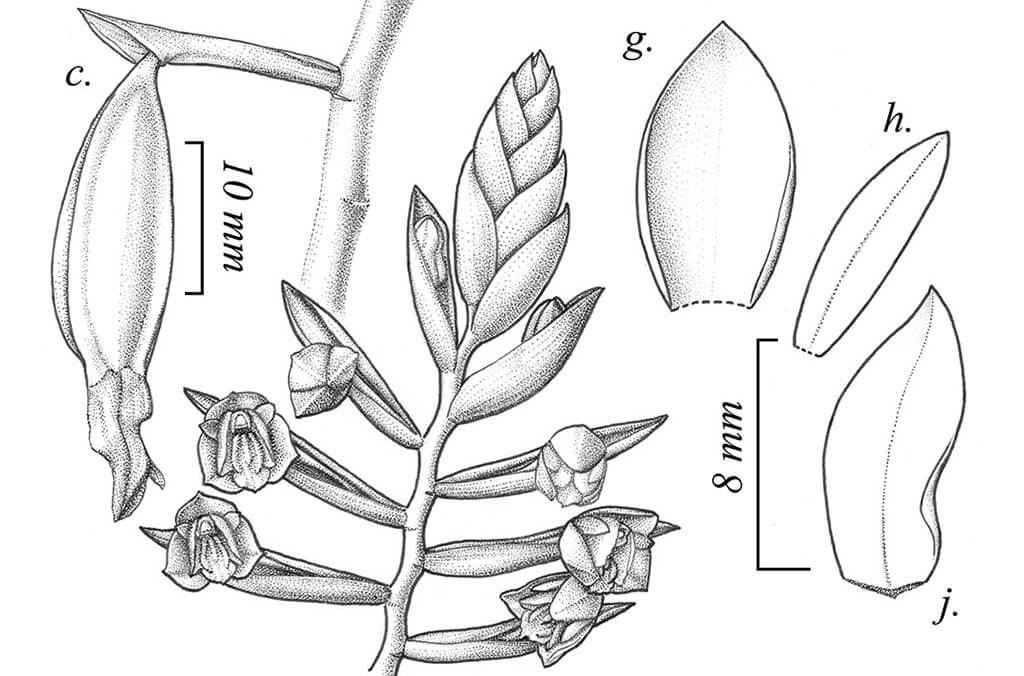
Second prize
Ernestia rubra by David Lucena, Brazil
This plate reflects an intriguing choice of media for the artist.
At first, observing the sensitive tones and variation in line weight, one assumes the work is created with a very restrained pencil. However, the crisp clarity of the plate reveals how features were in fact digitally enlarged to render the tiniest of details, then reduced again to become compact and well resolved – perfectly utilizing one of the greatest opportunities of digital media, while maintaining the artist’s hand-rendered style.
Details such as the observation of leaf hairs and the little habit with great depth, elevated this work to win 2nd Prize.
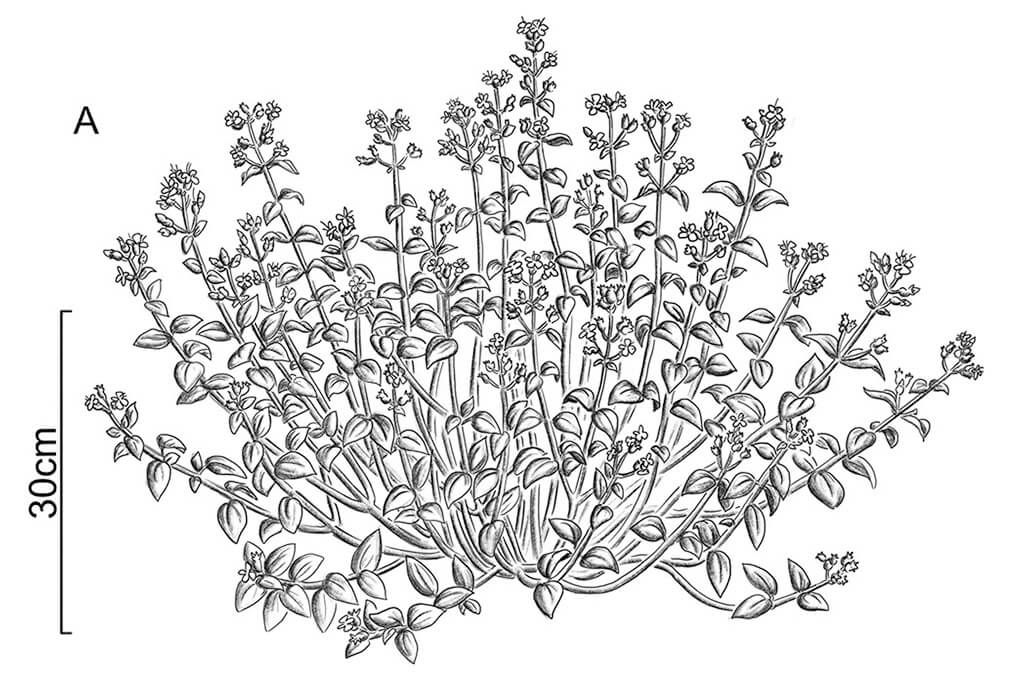
Highly commended
Bahiana occidentalis by Alice R. Tangerini, USA
Yet another use of digital media, working also with inked lines, this illustration explores the potential of rendering tone and form with variety and economy.
With limited access to reference material of this new species, the artist enjoyed creating fruiting and male floral parts that glow with airbrushed-style highlights and shadows, while accurately observing the seed surface pigmentation to create depth and realism.
A clever attribute of digital media, identical leaf shapes have been copied and pasted to swiftly create a sense of the habit without the hours of labour demanded by traditional media.
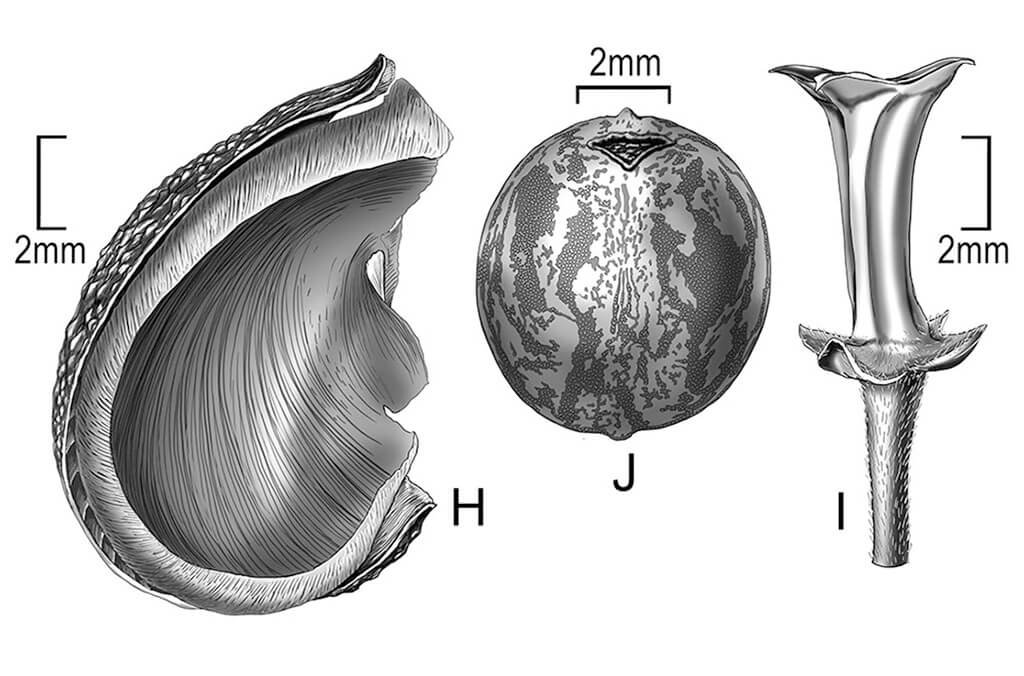
Highly commended
Bidens ferulifolia by María Teresa Jiménez, Mexico
Sometimes the quietest work speaks volumes.
This plate found its way through the selection process with its sheer technical restraint and accuracy.
A classic scientific illustration, the symmetrical features and concise information reveal all that is required to identify this plant, without any excess of detail or dramatic composing. An excellent technical achievement.
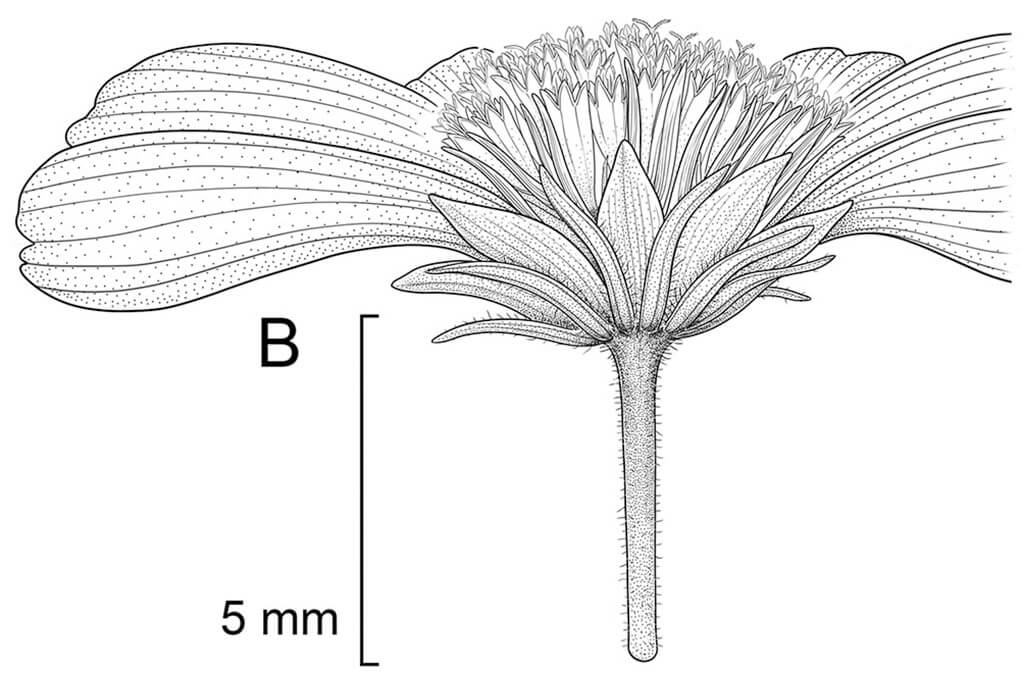
Highly commended
Ceiba chodatii by Irene Behrens, Argentina
An ambitious undertaking in graphite, this plate displays the breadth of capacity of the pencil medium in the hands of a skilled artist.
From the beautifully summarised habit to the ripened, fluffy fruits and the trichomes on the stigma tip, every plane of the pencil lead was deftly maneuvered to its best advantage.
Incredibly, the artist clearly illustrated many microscopic anatomical features while keeping the plate sharp and clean, a significant challenge of such soft media.
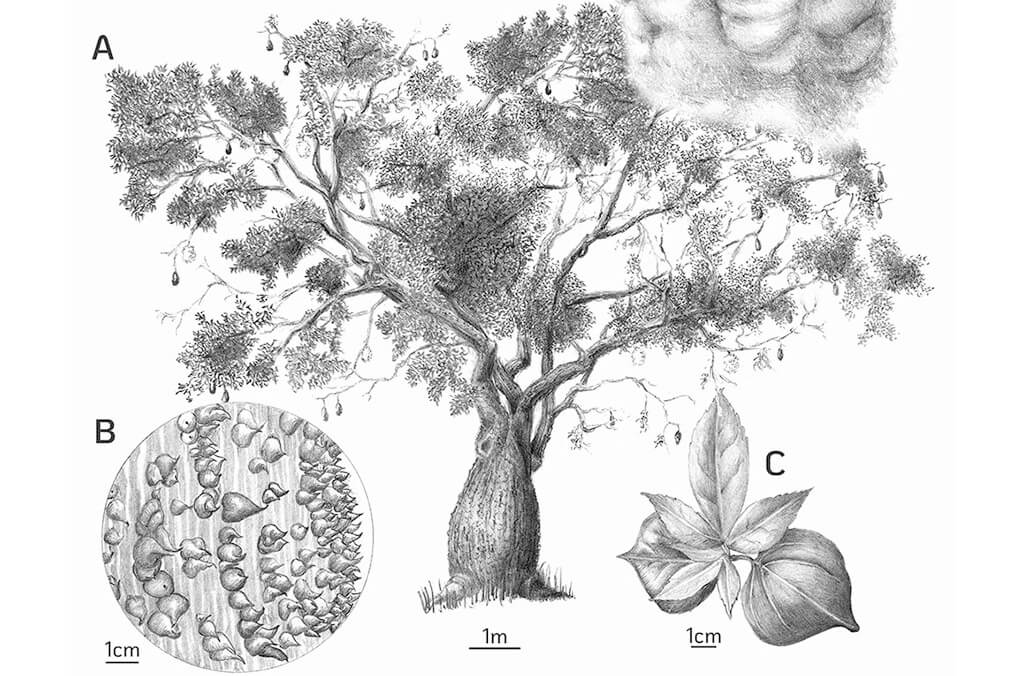
View previous years
View the winning entries for the 2024 Margaret Flockton Award on Flickr.
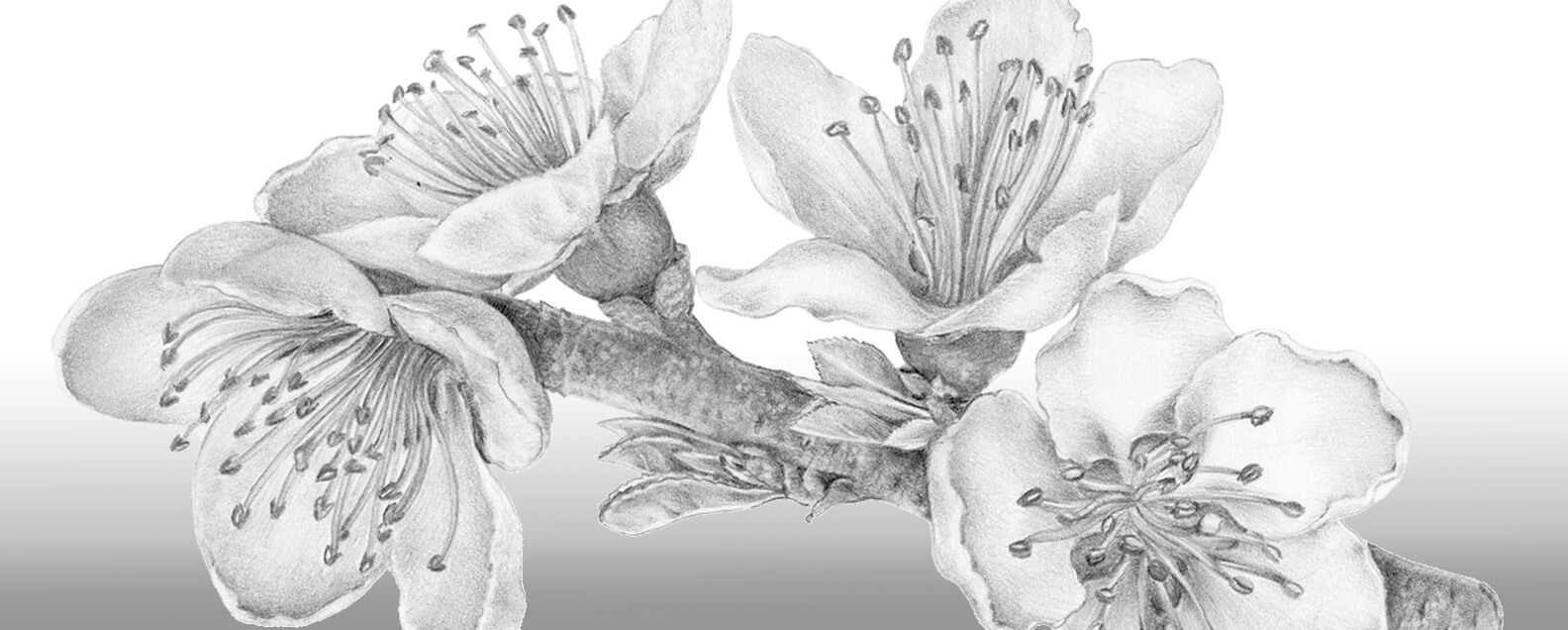
Call for entries
- All previous winners of the Margaret Flockton Award are eligible to enter, excluding 2022, 2023 and 2024 first prize-winning artists.
- There are no entry fees for the Margaret Flockton Award and Exhibition.
- Entries are to be submitted between Monday 12 May - Sunday 25 May 2025.
- Works must have been produced after May 2023.
- All illustrations and paperwork must be submitted digitally.
Each artist may submit up to two illustrations. Only high-resolution digital scans of black and white (for example pen and ink, graphite or scraperboard) illustrations and/or monochromatic, digitally rendered illustrations, either published or unpublished, will be considered. All illustrations must be intended for 2D-printed output. Animated or 3D rendered works or images dependent on digital viewing, as well as photos and photo montage works, are not eligible for submission.
Entries are to be digitally submitted at 100% of the original artwork size with an image area no larger than A3 (295mm x 420mm) and no smaller than (180mm x 250 mm), excluding legend.
Illustrations outside of these parameters will not be accepted. The digital canvas size may only be longer than A3 to allow for the legend. The illustration should include a small legend (with the plant name and all lettered components), neatly written or typed at the bottom of the artwork, outside of the image area.
Only full plate illustrations will be accepted (inclusive of habit study and diagnostic features of the species). The inclusion of scale bars, whilst not compulsory, is highly recommended.
Note: eligible entries may be printed at 67% of the original size to assess reproducibility at judging.
Due to the limitations of space, a selection of works will be made for the exhibition.
Illustrations selected for exhibition will be printed on high-quality paper and framed in standard exhibition frames. Some works may be enlarged for display, subject to artists' approval.
The Margaret Flockton Award Exhibition will display high-quality prints of submitted digital files only. Original artworks are neither exhibited nor sold at the Margaret Flockton Award Exhibition. If artists wish to provide an email or professional website address for direct enquiries, please enter details on the label/s and biography template and consent to their use via the entry form/s.
On the entry form, consent is sought for the following:
- For the Royal Botanic Gardens and Domain Trust to store and print one high-resolution copy of each entry for judging and exhibition.
- To allow high-resolution illustrations to be reproduced and biographical information to be used by the Royal Botanic Gardens and Domain Trust or the Foundation and Friends of the Botanic Gardens for the sole purpose of promoting the Margaret Flockton Award and Exhibition.
- To allow low-resolution illustrations to be created and biographical information to be viewed in an online ‘Flickr’ gallery format created by the Royal Botanic Gardens and Domain Trust and the Foundation and Friends of the Botanic Gardens.
- For your contact details to be publicly displayed on your biography and exhibition label.
The Royal Botanic Gardens and Domain Trust and the Foundation and Friends of the Botanic Gardens are the sole owners of the information collected from the entry forms and any other information submitted and will not sell or rent this information to others. Information will be shared for the sole purpose of advertising or promoting the Margaret Flockton Award and Exhibition. All care of artworks and the rights of artists will be respected and no illustrations will be commercially reproduced from this process.
All illustrations and paperwork must be submitted digitally via Dropbox.
Submit completed forms (1-4) with up to two image files to Dropbox.
Label your folder as follows: SURNAME MFA 2025 (eg. WARDROP MFA 2025).
Once you have created your account be sure to INVITE [email protected] to View AND Edit files in the shared folder where you have uploaded your image files.
Email [email protected] to notify the curators of your entry in Dropbox.
The Margaret Flockton Award Committee will contact you to confirm your image files have been received.
If you do not receive an email from the Committee within 5 days of submitting your entry please email your notification again.
Digital file specifications
- One high resolution digital file is to be submitted for each illustration.
- The file size should not exceed 200MB.
- Ink line and stipple - Bitmap tiff @ 1200dpi.
- Pencil or Continuous tone - Greyscale tiff or psd @ 600dpi (minimum).
- Jpg or colour files are not accepted.
- No photos of artworks will be accepted - scanned original works or digitally created images only.
Entries are to be digitally submitted at 100% of original artwork size with an image area no larger than A3 (295 mm x 420 mm) and no smaller than (180 x 250 mm), EXCLUDING legend. Illustrations outside of these parameters will not be accepted. The digital canvas size may only be longer than A3 to allow for the legend.
While large file transfer sites such as Dropbox are reliable and secure the Royal Botanic Gardens and Domain Trust and the Foundation and Friends of the Botanic Gardens will not be liable for any breaches of security associated with the transfer of digital images and information associated with the entries in the Margaret Flockton Award nor will they be responsible for any loss or damage of files in transit.
- Create a folder to upload your completed forms (1–4) in your Dropbox account.
- Label your folder as follows: SURNAME MFA 2024 (eg. WARDROP MFA 2024).
1. Complete an entry form
Each illustration must be accompanied by an entry form. When submitting this form you are agreeing to all of the conditions of entry. Please read all conditions carefully before submitting.
Incomplete entry forms may render entries ineligible. Please tick the checklist on the entry form to ensure all information has been supplied.
Label your entry form as follows: SURNAME entry form (eg. WARDROP entry form.docx).
2. Complete a label template
Each illustration is to be accompanied by a fully completed label template with the scientific name of the plant, medium, artist's name and the legend of the drawing. These will be printed and displayed with each work.
Label your label template as follows: SURNAME Plant name label template (eg. WARDROP Casuarina glauca label template.docx).
3. Complete a biography
The provision of biographical information, contact details and photo is completely optional.
Label your biography as follows: SURNAME biography (eg. WARDROP biography.docx).
For your biography an example has been provided on the link below with fields for your name, date and place of birth; education and career highlights; publication and exhibition history; website and email contact details. A suitable photo of the artist can be included.
Please limit the length of your biography to under two A4 pages.
Note: Original artworks are neither exhibited nor sold at the Margaret Flockton Award Exhibition. If artists wish to provide an email or professional website address for direct enquiries please enter details on the label/s and biography and consent to their use via the entry form/s.
4. Supply a taxonomic description
A taxonomic description (either published or unpublished) must be provided with each illustration. The taxonomic description should be typed and submitted electronically. This will not be framed with the artwork but will be available in a separate folder during the judging and exhibition. Examples of such descriptions can be found in local Flora publications or on PlantNET, an online resource for the plants of New South Wales.
Label your taxonomic description as follows: SURNAME Genus taxonomic description (eg. WARDROP Casuarina taxonomic description.docx).
Entries will be assessed in accordance with the following criteria:
- Accurate interpretation and portrayal of plant characters and diagnostic features
- Technical merit
- Reproducibility
- Composition
- Artistic merit
See 'A guide to scientific illustration' below for more information on judging criteria.
Works should be submitted as ready for publication and must be capable of being reduced to 67% of the original size without loss of detail. A major criterion of scientific illustration is that images should be clearly and simply reproduced through the printing process.
After judging or, in the case of exhibited works, at the conclusion of the exhibition period, all high-resolution digital files and printed illustrations will be destroyed with the exception of the winning, second prize and highly commended works. These are to be stored for historical and publicity purposes only. With the artist’s permission (see entry form) low-resolution jpegs will be available for online viewing from Thursday 7 August 2025 via our Flickr gallery.
First and second prize-winners will be paid by electronic transfer in Australian dollars soon after the awards are announced. Overseas artists will be paid by International Money Transfer in Australian dollars and will need to provide their bank account information upon request. Overseas artists should note their banking institutions may charge fees for international transactions
The science of botany requires plant taxonomists to describe plant species in both words and drawings, with botanists preparing a detailed description of the plant and the artist producing an accompanying illustration.
Taxonomic illustrations are normally published in scientific journals as highly detailed black and white drawings (primarily pen and ink, more rarely pencil) or digitally rendered illustrations (excluding photos and photo-montage), representing aspects of plant morphology essential for identification.
The Margaret Flockton Award is unique in art awards in that it recognises and promotes scientific botanical illustration as distinct from botanical art.
With the above in mind, the evaluation of entries is based on the following criteria:
- Accurate interpretation and portrayal of plant characters and diagnostic features noted in the botanical description
- Technical merit
- Reproducibility
- Composition
- Artistic merit
When considering these broad criteria, the following are also taken into account:
- Precision and accuracy: correct botanical detail, all plant characters and diagnostic features must be accurately displayed.
- Reproducibility: the image must be capable of being successfully scanned and reproduced (often reduced) without loss of detail. Very dense (black) or light detail may not reproduce well. A major criterion of scientific illustration is that images should be clearly and simply reproduced through the printing process. Illustrations must be capable of being reduced to 67% of the original size without loss of detail.
- Good composition: the plate should be laid out to give a balanced presentation allowing the overall effect to be aesthetically pleasing. Careful placement of the primary subject (usually the habit) should allow for a logical and easy to read arrangement of the dissected details of the plant.
- Use of scale bars, whilst not mandatory, is preferred. Great care should be taken in giving the correct scale of each feature. If possible, avoid using multipliers eg. 'x3' or 'x0.5' to indicate the size of features, as this becomes meaningless if the drawing is used in a publication and printed at a different size; the use of a scale bar is accurate regardless of changes to the size of the image.
- Signature: the signature should be neat, small and consistent, with the year noted.
Get in touch
For enquiries and further information please contact Lesley Elkan and Catherine Wardrop.
Address:
The Margaret Flockton Award
c/- Illustration
National Herbarium of New South Wales,
Australian Institute of Botanical Science,
Australian Botanic Garden Mount Annan.
Locked Bag 6002, Mount Annan NSW 2567
Australia
Related reading
